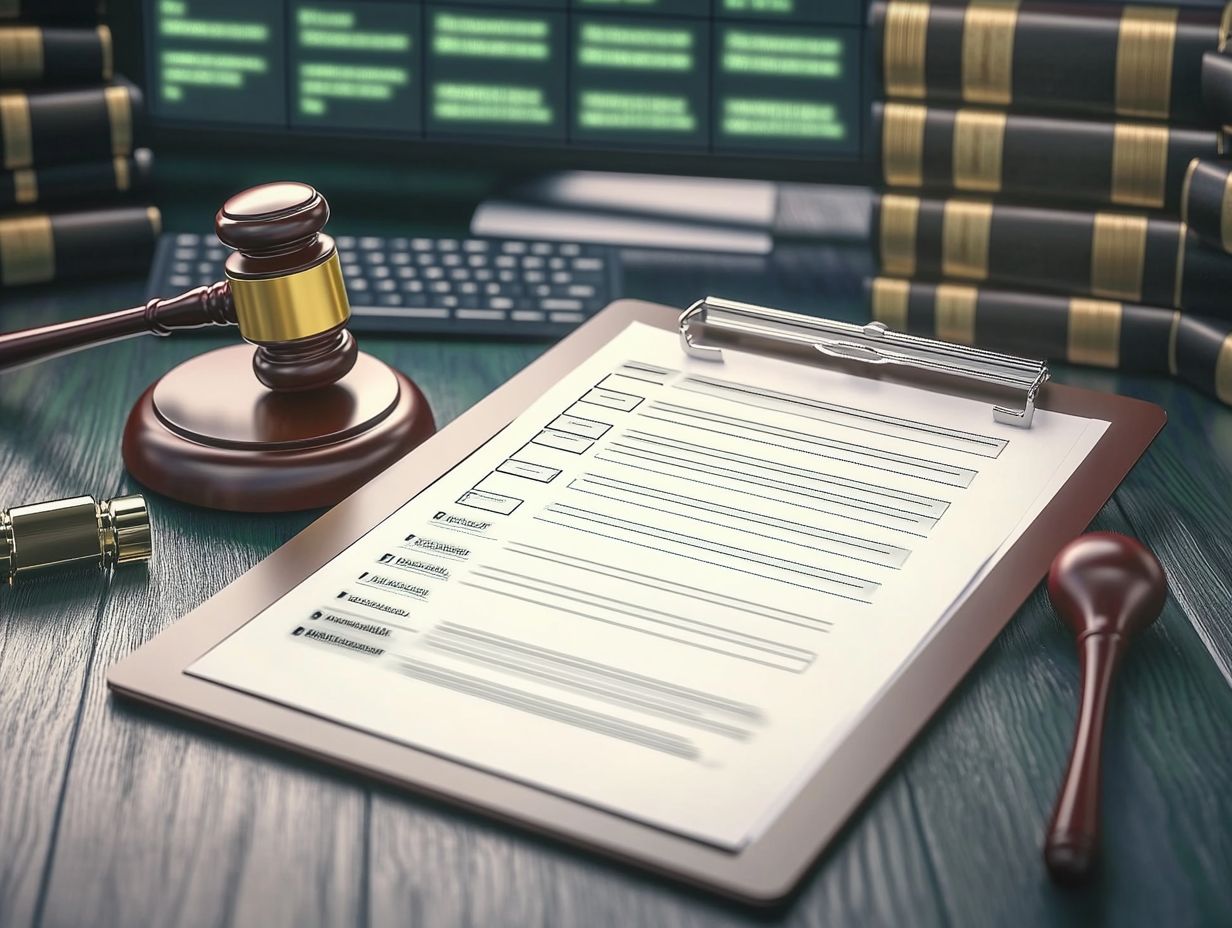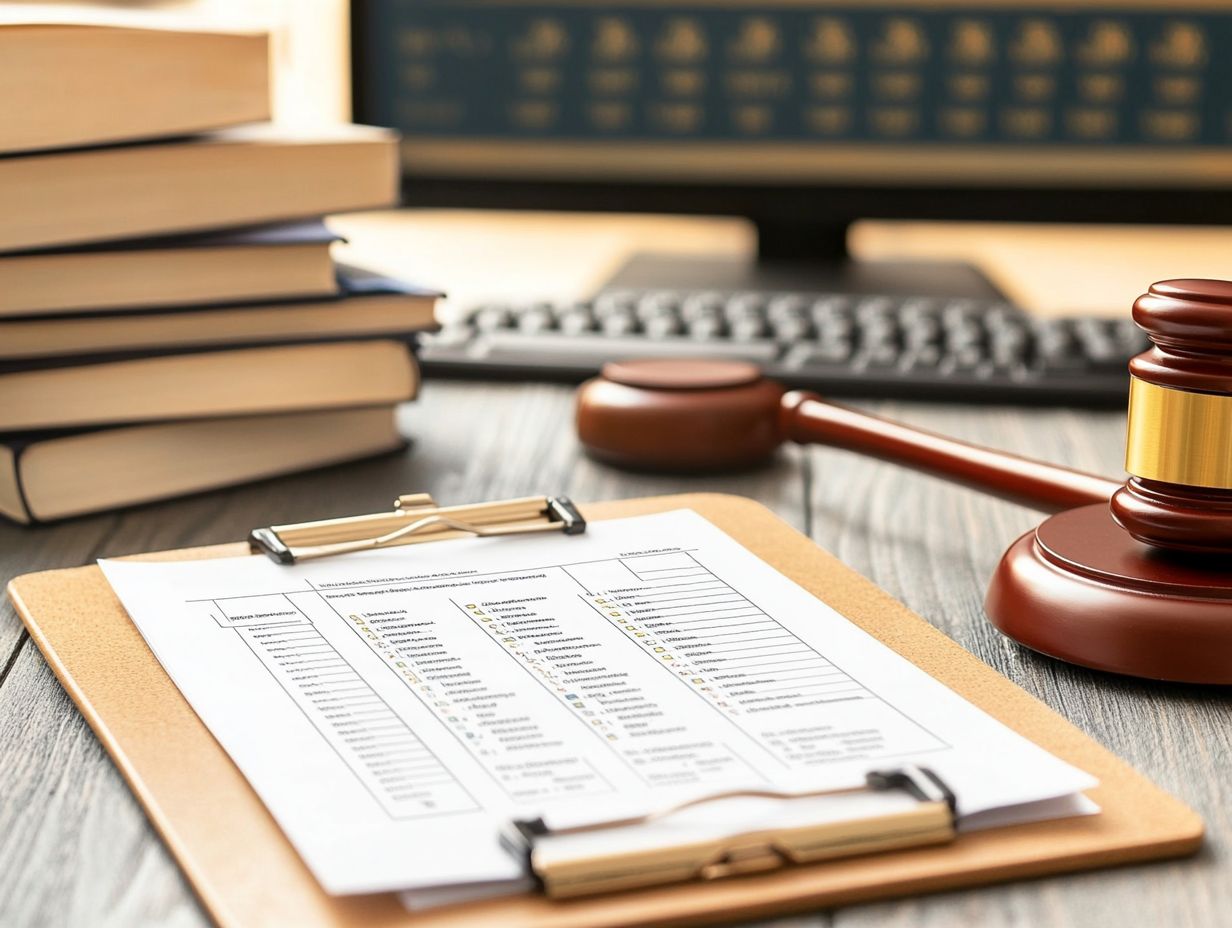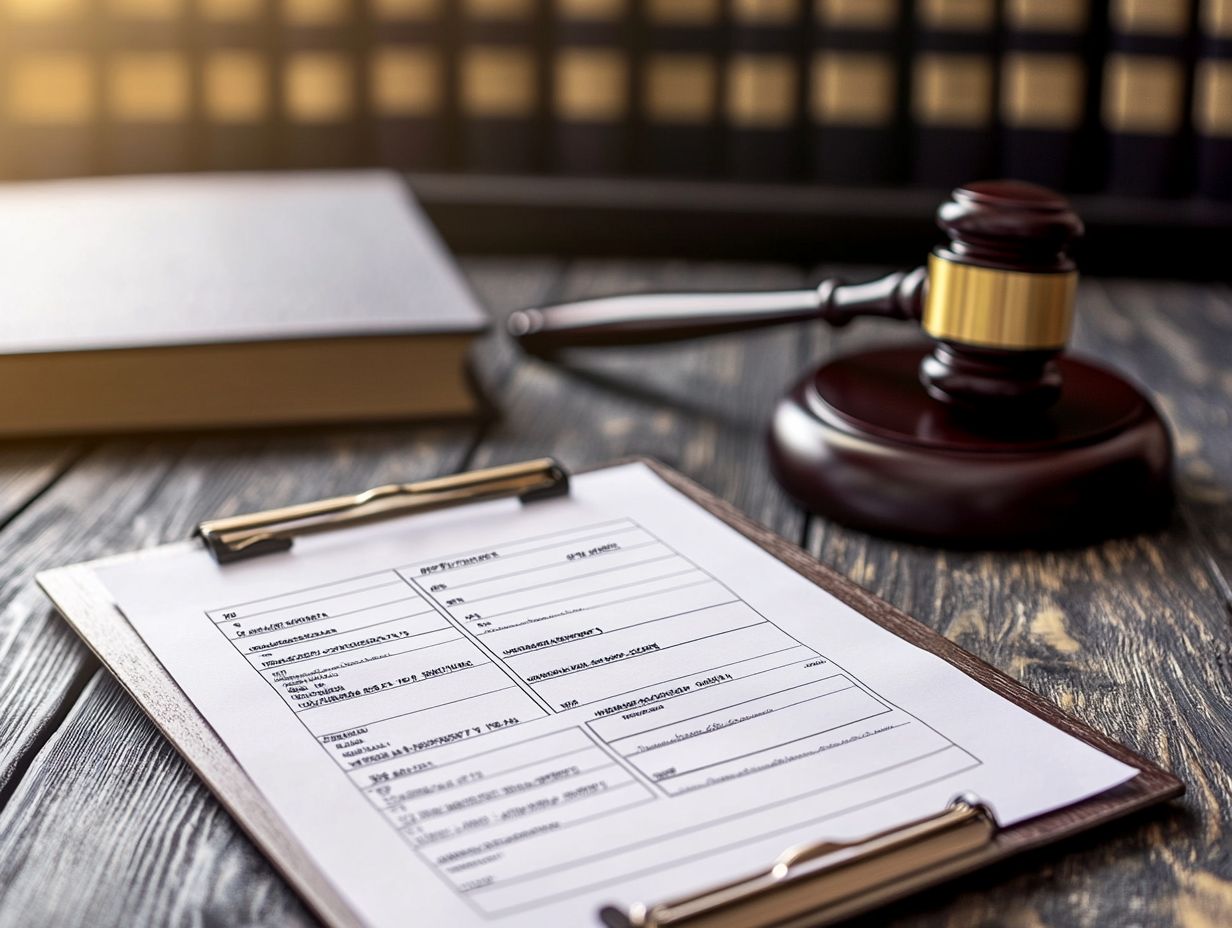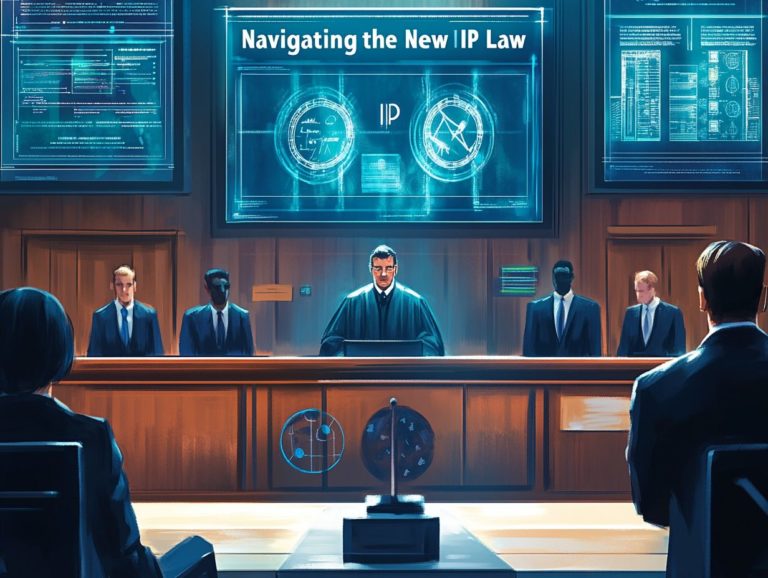Top 10 Common IP Litigation Mistakes to Avoid
Intellectual Property (IP) is crucial for fostering innovation and creativity. However, navigating its complexities can be quite a challenge. Many businesses encounter pitfalls that jeopardize their valuable assets and lead to expensive litigation.
This article delves into the top 10 common mistakes to avoid in IP litigation. From neglecting to conduct thorough searches prior to filing to overlooking the importance of consulting with seasoned attorneys, understanding these missteps empowers you to protect your intellectual property and ensure your business thrives.
Discover how to safeguard what you ve dedicated so much effort to create!
Contents
- Key Takeaways:
- 1. Not Conducting a Thorough IP Search Before Filing
- 2. Not Registering Your IP
- 3. Not Keeping Accurate Records of Your IP
- 4. Not Having a Clear IP Strategy
- 5. Not Enforcing Your IP Rights
- 6. Not Understanding the Jurisdiction for IP Litigation
- 7. Not Consulting with an Experienced IP Attorney
- 8. Not Understanding the Scope of Your IP Rights
- 9. Not Considering Alternative Dispute Resolution Methods
- 10. Not Properly Drafting or Reviewing IP Agreements
- What Is IP Litigation and When Is It Necessary?
- Frequently Asked Questions
- 1. What are the top 10 common IP litigation mistakes to avoid?
- 2. How can failing to properly secure intellectual property rights be a costly mistake in IP litigation?
- 3. Why is it important to conduct thorough research on the opposing party’s IP in an IP litigation case?
- 4. Can not having a clear understanding of IP laws and regulations be detrimental in an IP litigation case?
- 5. What are the potential problems of not addressing IP infringement immediately?
- 6. How can keeping accurate records help in an IP litigation case?
Key Takeaways:

Always conduct a thorough IP search before filing to dodge conflicts and infringement issues.
Register your IP to gain legal protection and establish ownership rights.
Keep accurate records of your IP to enforce and defend your rights in case of litigation.
Take action now to protect your innovations and secure your future!
1. Not Conducting a Thorough IP Search Before Filing
Conducting a thorough intellectual property (IP) search before filing a patent application is vital. It helps you identify existing patents and trade secrets that could impact your patent rights and potential infringement litigation.
You can leverage various types of IP searches, such as novelty searches and freedom-to-operate analyses, to better understand the competitive landscape. These searches reveal the current intellectual property environment and uncover opportunities that competitors might have missed.
Implementing a public disclosure strategy safeguards your innovations by preventing others from claiming similar ideas, helping you maintain a competitive edge.
Neglecting this step could lead to pitfalls like costly litigation, loss of exclusive market rights, or difficulty securing funding due to perceived risks issues that stifle growth and innovation.
2. Not Registering Your IP
Failing to register your intellectual property leads to significant ramifications. Without registered patents, you might not enjoy the full spectrum of legal protections and ownership rights vital for managing risks and creating value from your innovations.
Neglecting these registrations leaves you and your business exposed to infringement, resulting in lost revenue and diminished competitive advantages. The absence of trademarks or copyrights puts your creative works and brand identities at risk of misuse or imitation.
This uncertainty can drive investors away and stifle growth opportunities. It s crucial to navigate the intricacies of various forms of IP registration. Seeking legal counsel simplifies this complex process, ensuring that critical filings such as patents, trade secrets, and trademarks are accurately completed and safeguarded.
3. Not Keeping Accurate Records of Your IP
Keeping accurate records of your intellectual property is essential. This documentation process bolsters your patent application and ensures compliance with legal obligations related to patent rights and ownership.
To safeguard your innovations, maintain comprehensive records covering invention disclosures, detailed descriptions of the development process, and references to prior art that highlight existing technologies.
This diligent approach clarifies the timeline of your ideas and their evolution while strengthening your defense during legal proceedings. With well-organized documentation, you can effectively demonstrate ownership and originality, which is crucial in disputes.
Thorough records strengthen your position in litigation, minimizing the risk of costly legal missteps by providing clear evidence that supports your claims and counters potential infringements.
4. Not Having a Clear IP Strategy
A well-defined IP strategy is crucial for managing the complex tech world. It optimizes patent protection and aligns your innovation strategies with broader business goals and cost considerations.
This approach includes key elements like competitor analysis. By evaluating the strengths and weaknesses of rival firms, you can identify gaps and opportunities in the market.
Market intelligence improves your strategy by providing insights into trends and consumer preferences, allowing you to respond quickly.
Engaging legal counsel with expertise in IP law is essential. This ensures that all measures are legally robust, making your rights enforceable.
Successful case studies, like Apple’s focus on strict IP protection, show how a well-crafted strategy can lead to innovative breakthroughs and sustained competitive advantages.
5. Not Enforcing Your IP Rights
Failing to enforce your patent rights can have serious repercussions for your business. It may encourage competitors to infringe on your ideas, leading to costly litigation and threatening your legal standing.
This shows why you need to be proactive about managing your IP. There are effective mechanisms to enforce these rights, such as issuing cease-and-desist letters. These letters serve as formal notices, demanding that infringers stop their activities.
If informal measures don’t work, litigation may become necessary, allowing you to seek remedies in court. It’s essential for businesses to monitor their IP assets and stay vigilant.
This not only protects your innovations but also strengthens your competitive edge in the market.
6. Not Understanding the Jurisdiction for IP Litigation

Understanding the jurisdiction for IP litigation is vital. It influences your litigation strategy and can significantly affect legal compliance and outcomes in patent infringement cases, especially across different international jurisdictions.
Navigating jurisdiction becomes even more critical when considering potential courtroom repercussions. Landmark U.S. Supreme Court cases like *Hertz Corp. v. Friend* and *Goodyear Dunlop Tires Operations, S.A. v. Brown* illustrate how the choice of jurisdiction can shape a case, affecting which laws apply and the chances of winning a favorable ruling.
To manage jurisdictional complexities, conduct thorough research on federal and state rules. Consult with legal experts familiar with different jurisdictions and create a strategic plan early in the litigation process to identify the best venue.
7. Not Consulting with an Experienced IP Attorney
Consulting with an experienced IP attorney is crucial as you navigate patent prosecution. Their invaluable legal advice helps you avoid compliance issues and refine your patent strategy.
An IP attorney is key at each stage of the patent process, from drafting applications that clearly express your invention’s uniqueness to filing them in compliance with regulatory requirements.
Their expertise is essential for conducting prior art searches to assess your invention’s patentability. This lays a solid foundation for your application and ensures that all legal standards are met, reducing the risk of future disputes.
By leveraging their knowledge, you can mitigate legal risks, streamline the process, and increase the likelihood of successful patent grants.
8. Not Understanding the Scope of Your IP Rights
Understanding your IP rights clearly is essential. It clarifies your patent rights and informs critical decisions during claim drafting.
This includes the strategic use of transitional phrases, which connect different parts of a claim, playing a crucial role in patent applications. When analyzing claims, consider not just the specific language you use but also the broader context of your invention.
For instance, using transitional phrases like “comprising” or “consisting of” can significantly impact the claim’s breadth. These phrases indicate whether you re leaning toward inclusivity or exclusivity.
A well-crafted claim can help you sidestep potential infringement disputes and protect your interests as an innovator. Misjudging the claim’s scope can impose unintended limitations and jeopardize the enforceability or even the validity of your patent.
Understanding these nuances is crucial for achieving robust IP protection.
9. Not Considering Alternative Dispute Resolution Methods
Ignoring alternative dispute resolution (ADR) methods can significantly limit your options for resolving intellectual property conflicts. These approaches often present cost-effective and less adversarial solutions compared to traditional litigation while remaining compliant with legal obligations.
Mediation and arbitration offer unique benefits that can streamline your dispute resolution process. Mediation encourages collaboration and open communication with a neutral third party, fostering mutual understanding and often leading to outcomes that satisfy all parties involved.
On the other hand, arbitration provides a more structured setting where an arbitrator renders a binding decision after considering both sides. While ADR can save you time and money, it s essential to recognize potential drawbacks, such as the absence of an appeal process in arbitration.
For many businesses especially those aiming to preserve relationships or maintain confidentiality choosing ADR can be your best move for resolving disputes swiftly and effectively!
10. Not Properly Drafting or Reviewing IP Agreements
Properly drafting and reviewing your intellectual property agreements is absolutely essential. This includes employee agreements and non-disclosure agreements. Any lapse in legal compliance can lead to costly mistakes that undermine your patent protections and rights.
Make sure these documents include important sections, like confidentiality clauses, assignment of rights, and terms governing the use of proprietary information. It’s vital for you to work closely with legal counsel during this process, as they have the expertise to tailor agreements to your specific business needs and navigate the nuances of applicable laws.
Be wary of common pitfalls, such as vague language or failing to define key terms, which can jeopardize your company s legal standing. For instance, if the scope of a non-disclosure agreement isn’t explicitly stated, you might inadvertently allow former employees to misuse sensitive information.
To steer clear of these issues, ensure that your agreements are clear and comprehensive. Establish regular review cycles to stay updated on evolving legal standards.
What Is IP Litigation and When Is It Necessary?
Intellectual property (IP) litigation encompasses the legal disputes that arise from enforcing patent rights. These disputes are often triggered by patent infringement claims and are crucial for preserving the integrity of IP assets in the marketplace.
These disputes can profoundly affect businesses, shaping their innovation processes and competitive edge. Common scenarios leading to IP litigation include the unauthorized use of patented technology, trademark infringements, and copyright violations, particularly in fast-paced industries like technology and pharmaceuticals.
Navigating these intricate legal waters demands skilled legal counsel capable of providing strategic guidance, assessing the merits of the case, and advocating effectively for your interests. This ensures that the protection of your intellectual property remains both robust and compliant with existing laws.
What Are the Most Common Types of IP Litigation?

The most common types of IP litigation include patent infringement cases, trade secret misappropriation, and copyright disputes. For a deeper insight, refer to understanding IP litigation, as each type has its own challenges, making it important to seek specialized legal advice.
Understanding these issues is vital for your business. For example, patent infringement cases often focus on showing that a competitor has used or sold a patented invention without permission. This can lead to significant financial losses or orders to stop further infringement.
Trade secret misappropriation focuses on the unauthorized use of sensitive company information that is not shared publicly. You need to show that you’ve taken steps to protect that information.
Copyright disputes involve the unauthorized use of creative works, with possible outcomes ranging from financial damages to the removal of infringing content. Case studies in these areas highlight the complexities of legal battles.
What Are the Steps Involved in IP Litigation?
The IP litigation process usually unfolds through several key steps:
- Filing a complaint
- Discovery
- Trial
- Potential appeals
Each of these stages is important for enforcing patent rights. Your legal counsel plays a vital role in formulating claims. They assess your case’s merits and gather the evidence needed to support your position.
The discovery phase is where your legal team uncovers vital information from the opposing party. They meticulously collect and analyze all relevant evidence. This step is critical for developing effective strategies.
As your case goes to trial, your legal counsel must present their findings skillfully. They demonstrate a clear understanding of the facts and applicable laws while preparing for the possibility of appeals.
How Can a Business Protect Itself from IP Litigation?
You can protect your business from IP litigation by implementing strong legal compliance measures and effective risk management strategies. Ensure that employee agreements clearly define IP ownership and responsibilities.
Conduct regular IP audits to identify vulnerabilities and uncover opportunities for improvement. This helps secure your valuable intellectual property.
Investing in employee training raises awareness about the importance of IP. It empowers your team to follow best practices in innovation and compliance.
Fostering a culture of innovation encourages creative thinking while emphasizing accountability in managing intellectual property. This approach helps your organization stay vigilant against potential litigation risks. Act now to protect your business!
What Are the Possible Outcomes of IP Litigation?
The outcomes of IP litigation can vary widely, from monetary damages for patent infringement to injunctions that halt further violations. This significantly impacts the enforcement of patent rights and underscores the necessity of experienced legal counsel to navigate these complexities effectively.
When your business is entangled in such disputes, the stakes are incredibly high. A successful settlement can help you avoid protracted courtroom battles, securing favorable terms that protect your interests while minimizing risks to your intellectual property portfolio.
Conversely, a judgment against you could lead to substantial financial penalties, disrupt your operations, and require changes in your product distribution practices.
If the losing party opts to appeal the decision, it risks prolonging the uncertainty and complicating your strategic planning for the future. These diverse outcomes affect not just your immediate operations; they also shape your long-term IP strategies, influencing how you develop and safeguard your innovations moving forward.
What Are the Costs Associated with IP Litigation?
The costs associated with IP litigation can add up quickly, encompassing legal expenses, court fees, and potential damages. Effective budget management and a well-defined litigation strategy are essential as you pursue or defend against IP claims.
Costs typically include attorney fees, expert witness charges, and expenses tied to the discovery process. Don’t overlook the indirect costs as well; impacts on your business operations, management time diverted from core activities, and potential reputational damage can further strain your resources.
To navigate these financial hurdles effectively, consider the following strategies:
- Impose strict budget limits.
- Explore alternative dispute resolution methods.
- Prioritize cases based on potential return on investment.
By employing strategic planning and closely monitoring your expenditures, you can mitigate risks and enhance your chances of achieving a favorable outcome in litigation.
This video discusses key strategies for managing IP litigation effectively.
Frequently Asked Questions
1. What are the top 10 common IP litigation mistakes to avoid?

The top 10 common IP litigation mistakes include:
- Failing to secure intellectual property rights.
- Using outdated or incorrect information in legal documents.
- Not conducting thorough research on the opposing party’s IP.
- Not understanding IP laws and regulations.
- Not seeking legal advice when needed.
- Failing to keep accurate records and documentation.
- Not protecting trade secrets.
- Using weak or unenforceable non-disclosure agreements.
- Not documenting ownership of IP properly.
- Not addressing IP infringement immediately.
2. How can failing to properly secure intellectual property rights be a costly mistake in IP litigation?
Failing to secure intellectual property rights can lead to loss of exclusivity, inability to enforce rights, and potential lawsuits from competitors or former employees. It can also weaken your case in court and decrease the chances of a successful outcome.
3. Why is it important to conduct thorough research on the opposing party’s IP in an IP litigation case?
Conducting thorough research on the opposing party’s IP is crucial. It can reveal potential weaknesses in their case, help you understand their legal strategy, and improve your chances of preparing a strong defense. It can also help identify possible infringement on your IP, strengthening your position in the case.
4. Can not having a clear understanding of IP laws and regulations be detrimental in an IP litigation case?
Yes, lacking a clear understanding of IP laws and regulations can be detrimental. It can result in mistakes in legal filings, failure to protect your IP rights, and difficulties in effectively negotiating or defending against claims. Seek legal advice and stay updated on changes in IP laws and regulations.
Understanding IP litigation is essential for protecting your business. Don’t risk your business; act quickly to secure your IP rights and avoid pitfalls, such as those outlined in the top 10 trademark registration mistakes to avoid!
If you have concerns regarding IP litigation, consider contacting a legal expert or reviewing your IP portfolio for comprehensive protection.
5. What are the potential problems of not addressing IP infringement immediately?
If you don t address IP infringement right away, you could face financial loss and damage to your reputation. You might also lose your competitive edge and weaken your position in court.
Act now to protect your IP rights!
6. How can keeping accurate records help in an IP litigation case?
Accurate records provide strong evidence to back your claims in court. They help you track the use and ownership of your Intellectual Property (IP), which is vital in infringement cases.
Well-documented records show your commitment to protecting your IP rights, giving you an advantage in legal situations.






